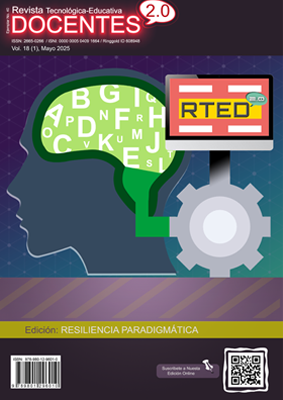Critical Evaluation of the Use of Technology in Education
 DOI:
https://doi.org/10.37843/rted.v18i1.601
DOI:
https://doi.org/10.37843/rted.v18i1.601
Main Article Content
Abstract
Nowadays, due to technological advances, the educational system has been forced to make significant changes to its curricular grids to adapt to these new challenges. However, integrating technology in the classroom involves facing various myths that have been debated in educational organizations. The main objective of the research was to demonstrate that some of these myths are unfounded and, at the same time, to facilitate an analytical evaluation of the use of technology in educational environments. The study is framed within the humanistic paradigm, a systematic method with a qualitative approach, a documentary-type narrative design, and a cross-sectional section. A literature review was carried out that included studies from databases specialized in education and technology, considering 17 investigations published between 2010 and 2023. The techniques used were bibliographic review and analysis of the texts selected for the study. The research results show that technologies can contribute to personalizing learning and serve as motivational tools, although their impact depends on the context in which they are implemented. The discussion highlights the importance of thoughtful and evidence-based use, avoiding creating unrealistic expectations about its effectiveness. Finally, considering its advantages and limitations, it is concluded that a balanced approach is needed in integrating technology into the educational system.
Downloads
Metrics
Article Details

This work is licensed under a Creative Commons Attribution-NonCommercial-NoDerivatives 4.0 International License.
Those authors who have publications in our journal accept the following terms:
- When a work is accepted for publication, the author retains rights of reproduction, distribution of his/her article for exploitation in all countries of the world in the format provided by our magazine and any other magnetic medium, optical, and digital.
- Authors will retain their copyright and guarantee the journal the right first to publish their work, which will be simultaneously subject to the Creative Commons Acknowledgment License (Attribution-NonCommercial-NoDerivatives 4.0 International (CC BY-NC-ND 4.0)). That allows third parties to copy and redistribute the material in any medium or format, under the following conditions: Acknowledgment - You must properly acknowledge authorship, provide a link to the license, and indicate if any changes have been made. You may do so in any reasonable way, but not in a way that suggests you have the licensor's endorsement or receive it for your use. NonCommercial - You may not use the material for a commercial purpose. NoDerivatives - If you remix, transform, or build from the material, you cannot broadcast the modified material. There are no additional restrictions - You cannot apply legal terms or technological measures that legally restrict you from doing what the license allows.
- Authors may adopt other non-exclusive license agreements to distribute the published version of the work (e.g., deposit it in an institutional archive or publish it in a monographic volume) provided that the initial publication in this journal is indicated.
- Authors are allowed and recommended to disseminate their work through the Internet (e.g., in institutional telematic archives, repositories, libraries, or their website), producing exciting exchanges and increasing the published work's citations.
- Request of withdrawal an article has to be done in writing by the author to the Editor, becoming effective after a written response from the Editor. For this purpose, the author or authors will send correspondence via e-mail: [email protected].
- The author will not receive financial compensation for the publication of his work.
- All Docentes 2.0 Journal publications are under the Open Journal System (OJS) platform at: https://ojs.docentes20.com/.
References
Axtell, P., & Mnookin, J. (2020). Make Virtual Learning Matter: How to Turn Virtual Classrooms Into a Remarkable, Authentic Experience for Kids. Sourcebooks. https://n9.cl/kq64w
Bullón-Solís, O. (2020). Educación virtual interactiva como metodología para la educación: revisión de literatura. Crescendo, 11(2), 225-238. http://dx.doi.org/10.21895/incres.2020.v11n2.06 DOI: https://doi.org/10.21895/incres.2020.v11n2.06
Copertari, S. & Lima, Z. (2023). Educación en la era tecnológica: Práctica de la enseñanza mediada por tecnologías digitales en la educación del siglo XXI. Revista de Ciencias de la Educación, 8(13). https://doi.org/10.46616/rce.v8i13.94 DOI: https://doi.org/10.46616/rce.v8i13.94
Dede, C. (2010). Comparing frameworks for 21st century skills. In J. Bellanca & R. Brandt (Eds.), 21st century skills: Rethinking how students learn (pp. 51-76). Solution Tree Press.
Deci, E. L., & Ryan, R. M. (2000). The “what” and “why” of goal pursuits: Human needs and the self-determination of behavior. Psychological Inquiry, 11(4), 227-268. https://n9.cl/n3hhj1 DOI: https://doi.org/10.1207/S15327965PLI1104_01
De Souza, M. (2020). Tecnologías de la educación en América Latina: un análisis crítico. Educación y Sociedad, 41(15), 23-30. https://n9.cl/37rka
Elgohary, H. K. A., & Al-Dossary, H. K. (2022). The effectiveness of an educational environment based on artificial intelligence techniques using virtual classrooms on training development. International Journal of Instruction, 15(4), 1133-1150. https://n9.cl/sgb6m DOI: https://doi.org/10.29333/iji.2022.15460a
González, J., (2018). Uso de las tecnologías en la educación. El auto-aprendizaje para docentes de e-learning. Editorial Digital UNID. https://n9.cl/17vke
Hattie, J., & Yates, G. (2014). Visible learning and the science of how we learn. Routledge. https://n9.cl/o3rqk DOI: https://doi.org/10.4324/9781315885025
Lion, C. (2019). Los desafíos y oportunidades de incluir tecnologías en las prácticas educativas. Análisis de casos inspiradores. IIPE UNESCO Oficina para América Latina. https://n9.cl/xx6d2
Ortega T., J., & Ortiz C, A., (2018). Tecnología en entornos educativos. Ediciones Paraninfo, S.A. https://n9.cl/qt8cjq
Prensky, M. (2017). Education to Better Their World: Unleashing the Power of 21st CenturyKids. Corwin. https://n9.cl/fvz631
Rosenberger, S. (2019). Tecnologías de la información y la comunicación, educación y apropiación en América Latina. Revista Iberoamericana de Ciencia, Tecnología y Sociedad-CTS, 14(40), 11-39. https://n9.cl/e3ejze
Salinas Amescua, B. (2004). Tecnologías de información, educación y pobreza en América Latina: los telecentros: conceptos, estudios y tendencias. Plaza y Valdés. https://n9.cl/e8fojx
Sevilla, H., Tarasow F., & Luna, M. (coords.) (2017). Educar en la era digital. Pandora. https://n9.cl/be9v3
Selwyn, N. (2016). Education and technology: Key issues and debates. Bloomsbury Publishing. https://n9.cl/7zwl9 DOI: https://doi.org/10.5040/9781474235952
Zhao, Y. (2018). What works may hurt: Side effects in education. Teachers College Press. https://n9.cl/anl1tm DOI: https://doi.org/10.1007/s10833-016-9294-4






